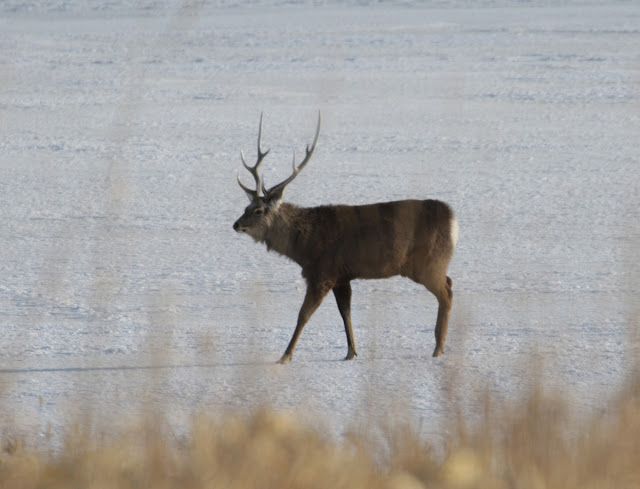I've only only been to see Blakiston's twice in winter, staying at Washi no Yado five years ago and this month at Yoroushi Onsen. The two experiences are very different in terms of accommodation but as the Owls are the important thing it might not matter too much for someone who has never seen these magnificent birds. I would just say Yoroushi is far more comfortable and I wouldn't hesitate staying more than one night if I wanted to give the area more time. Whereas one successful night at Washi no Yado would be enough, I'd look for alternative accommodation if I wanted to spend longer in the area. But, and it's a big but, the food was fantastic at Washi no Yado.
An Owl arrived during dinner at Washi no Yado and after eating more quickly than I'd have otherwise chosen I sat outside in my rental car to get a better view. This steep, narrow valley is cold, really cold, and the car needed a jump start the following morning. The owner told me the same had happened to another birder the day before. The local garage was doing good business. The small pool in the middle of the river is kept stocked with fish (at least as long as people are viewing it seems) so there's plenty of time to watch the Owls coming and going or just sitting in the snow. The problem is you are virtually sitting in the snow too and I'm not as tough as the Owls so there was a limit to how long I could sit motionless in the car with the windows open in minus (a large number) degrees. Of course you could watch from the minshyuku but that would double the distance to the birds.
Similarly the Yoroushi Owl arrived while we were still at the dinner table and caught me off guard. Stupidly I'd left my camera in my room and by the time I dashed to get it the window was already lined by (mostly) non-birders and I had to hand-hold the camera at the back of the group as a result. This would have been easily avoidable if I'd been aware of the feeding regime. Unlike the protracted viewing at Washi no Yado, with fish being put out as required, there were just two feeding sessions, one between 6-7pm as I recall and the other must have been between 5-6am. There's actually a calendar pinned up next to the office giving the times of daily sightings but the penny didn't drop that these neat clusters of sightings were dependant on when fish were put out. The result is that though the views are remarkably close, they are also relatively brief before the Owl polishes off the fish and disappears into the surrounding darkness along the river. It also resulted in me getting very few shots of the bird as I thought I'd have plenty of time after the crowd lost interest.
So which site is better for the Owls? The view is much closer at Yoroushi, maybe only eight metres, and the experience is slightly surreal from the warmth of the lounge. If you want a more authentic and slightly more distant, cold, freezing cold, really freezing cold experience then Washi no Yado wins hands down. If you intended to watch from indoors at Washi no Yado then I'd definitely recommend staying at Yoroushi.
I suppose the supporting cast needs to be considered too. Washi no Yado had Brown Dipper on the river in front of the minshyuku and common woodland birds in the surrounding woodland. Yoroushi had Solitary Snipe and Crested Kingfisher on the river in front of the ryokan and common woodland birds on the feeders right outside the window. Better for me, it also had Sable, a mammal tick, coming to the feeders too.
Kicking off with the Washi no Yado birds under the powerful spotlights...
In in reply, Yoroushi...
Coming back to the supporting cast...
 |
| sable |
 |
| red fox |
 |
| This Solitary Snipe was on the near bank of the river and as such wasn't visible from inside the minshyuku. |
 |
| Great Spotted Woodpecker. Compared to woodpeckers in Honshu I always think that the Hokkaido birds are tripping over themselves to get in front of any camera. However this GSW was the only one to give itself up on this trip. Though admittedly we weren't really after any woodland species and didn't spend more than a daylight hour or two at this our only woodland stop on the trip. |
 |
| Marsh Tits were common, a great little bird we can't see in Honshu. |
 |
| The brandtii Jay of Hokkaido... I can't resist putting a comparative shot of the Honshu japonicus below. |
 |
| Probably the only thing their respective heads have in common is a bill. The pattern of white in the wing is quite different too. |

















































